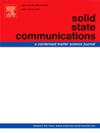寿命感温CeF3-YF3-TbF3纳米颗粒发光动力学表征
IF 2.1
4区 物理与天体物理
Q3 PHYSICS, CONDENSED MATTER
引用次数: 0
摘要
采用共沉淀法合成了Ce0.5Y0.5-XTbXF3 (X = 0.001, 0.01, 0.05, 0.1和0.2)纳米粒子。样品的平均直径约为20 nm,其六角形相与CeF3基体相一致。在266 nm激发下(Ce3+的4f - 5d吸收带),所有样品都发出Tb3+的亮绿色发光。有效衰减时间τeff在303 ~ 523温度范围内表现出复杂的温度依赖关系,包括上升部分和衰减部分。我们提出了两个假设来解释Tb3+ τeff的温度依赖性。一是随着温度的升高,Tb3+离子之间的距离增大,浓度猝灭效率降低,产生热膨胀现象。第二个假设认为Tb3+的激发是通过Ce3+离子或晶格缺陷来实现的。在缺陷的情况下,它们“收集”激发能,然后填充Tb3+离子。随着温度的升高,该居群的效率增加,从而导致Tb3+的寿命延长。在较高温度下τeff函数的减小部分可以用多声子猝灭的贡献来解释。所研究的Ce0.5Y0.5-XTbXF3 (X = 0.001, 0.01, 0.05, 0.1, 0.2)样品具有较好的性能。其中,最大Sr值在0.2 ~ 0.4% /K范围内。本文章由计算机程序翻译,如有差异,请以英文原文为准。
Luminescence kinetic characterization of CeF3-YF3-TbF3 nanoparticles for lifetime temperature sensing
The Ce0.5Y0.5-XTbXF3 (X = 0.001, 0.01, 0.05, 0.1, and 0.2) nanoparticles were synthesized via the co-precipitation method. The samples demonstrated average diameters around 20 nm and hexagonal phase corresponding to the CeF3 matrix. Under 266 nm excitation (4f – 5d absorption band of Ce3+), all the samples showed bright green luminescence of Tb3+. In turn, the effective decay times (τeff) demonstrated the complicated temperature dependence in the 303–523 temperature range including rising and decaying parts. We suggested two hypotheses explaining such temperature dependence of τeff of Tb3+. The first one is related to the thermal expansion phenomenon when Tb3+ ions distance from each other with the temperature increase and the efficiency of the concentration quenching decreases. The second hypothesis suggests that the excitation of Tb3+ is performed through both Ce3+ ions or crystal lattice defects. In the case of defects, they “collect” the excitation energy and then populate Tb3+ ions. The efficiency of this population increases with the increase of temperature which leads to the increase of the lifetime of Tb3+. The decreasing part of the τeff function at higher temperatures was explained by the contribution of multi-phonon quenching of the luminescence. The studied Ce0.5Y0.5-XTbXF3 (X = 0.001, 0.01, 0.05, 0.1, and 0.2) samples showed competitive performances. Specifically, the maximal Sr values are in the 0.2–0.4 %/K range.
求助全文
通过发布文献求助,成功后即可免费获取论文全文。
去求助
来源期刊

Solid State Communications
物理-物理:凝聚态物理
CiteScore
3.40
自引率
4.80%
发文量
287
审稿时长
51 days
期刊介绍:
Solid State Communications is an international medium for the publication of short communications and original research articles on significant developments in condensed matter science, giving scientists immediate access to important, recently completed work. The journal publishes original experimental and theoretical research on the physical and chemical properties of solids and other condensed systems and also on their preparation. The submission of manuscripts reporting research on the basic physics of materials science and devices, as well as of state-of-the-art microstructures and nanostructures, is encouraged.
A coherent quantitative treatment emphasizing new physics is expected rather than a simple accumulation of experimental data. Consistent with these aims, the short communications should be kept concise and short, usually not longer than six printed pages. The number of figures and tables should also be kept to a minimum. Solid State Communications now also welcomes original research articles without length restrictions.
The Fast-Track section of Solid State Communications is the venue for very rapid publication of short communications on significant developments in condensed matter science. The goal is to offer the broad condensed matter community quick and immediate access to publish recently completed papers in research areas that are rapidly evolving and in which there are developments with great potential impact.
 求助内容:
求助内容: 应助结果提醒方式:
应助结果提醒方式:


